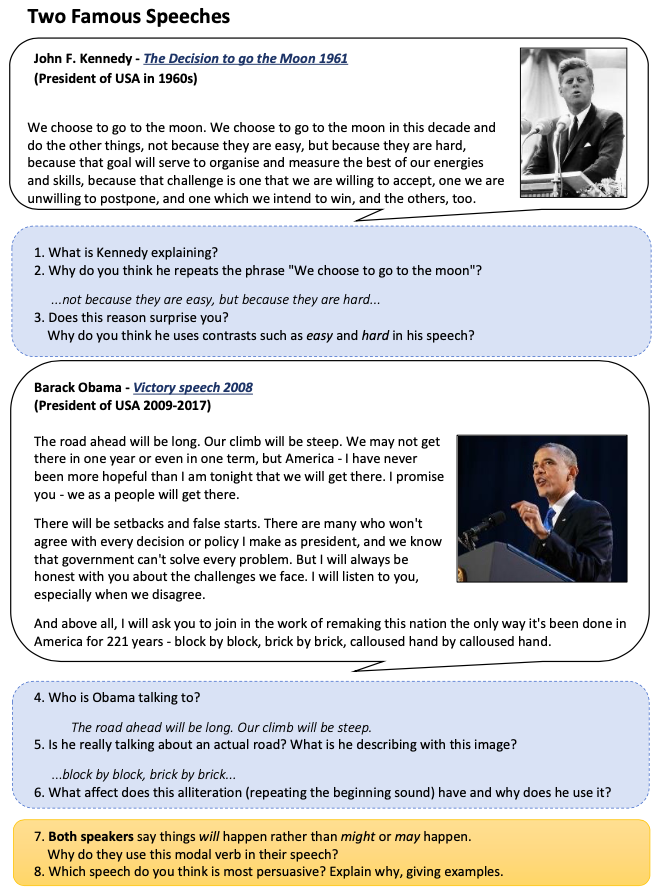Tuesday 16th June
English L.O: To identify the language features of a powerful speech.Activity 1: Listen to Chapter 20 of 'The Stolen Sister' on the Learning --> Stories page of the website. Activity 2: Watch this clip explaining about a famous speech: I Have A Dream
Activity 3: Open up the file below titled 'Language Features'. Now, watch this second clip about the language in the speech you have just heard. Make notes of the Language Features that you learn about as you watch and listen to this analysis by poet, Benjamin Zephaniah: I Have A Dream (Analysis) Activity 4: Take a look at these two famous speeches and answer the follow-up questions 1-8:
Activity 5: Open up the file below titled '3 Famous Speeches'. Read the 3 speeches by Winston Churchill, Elizabeth I and William Lyon Phelps then answer the 10 follow up questions. Activity 6: Open up 'Famous Speeches (Answers) and mark your answers for Activity 4 & 5. |
MathsYear 5 L.O.: To find a fraction of an amount.Activity 1: Re-watch the demonstration video below for today's lesson.
Activity 2: Open up the file below titled 'Y5 Reasoning & Problem Solving' and complete either the Bronze, Silver OR Gold page. There are 6 questions for each level. Use the answers on page 4 to mark your work when you have answered all 6 qus.
Activity 3: For a (Platinum) challenge open up 'Y5 Maths Challenge' and have a go at answering the 2 discussion problems (answers are on page 2) Year 6 L.O.: To order decimals, percentages and fractions.Activity 1: Re-watch the demonstration video below for today's lesson.
Activity 2: Open up the file below titled 'Y6 Reasoning & Problem Solving' and complete either the Bronze, Silver OR Gold page. There are 6 questions for each level. Use the answers on page 4 to mark your work when you have answered all 6 qus.
Activity 3: For a (Platinum) challenge open up 'Y6 Maths Challenge' and have a go at answering the 2 discussion problems (answers are on page 2) |
History L.O:To understand the main factors in the creation of industrial Britain.In 1837, Britain was still a rural nation with 80% of the population living in the countryside. Most people were farmers or spun wool and cotton to weave into cloth. Soon new machines were invented that could do these jobs in a fraction of the time. This left many people out of work, so they flocked to the towns in search of jobs in new industries. By the middle of the nineteenth century over 50% of the population lived in towns and cities. Activity 1: Learn more about this time known as 'The Industrial Revolution' in the two videos below. Make note of any interesting facts you learn in your home learning books:
The Industrial Revolution happened over a long period of time rather than suddenly. Just like baking a cake, the ingredients for the Industrial Revolution had to be present together at the right time and then left to heat up... There were six main factors (ingredients) that came together to create the Industrial Revolution.
Activity 2: Open up the file below titled 'The Industrial Revolution'. Read through these slides carefully to learn more about these 6 main factors that came together to create The Industrial Revolution. Activity 3: Open up the worksheet below titled 'The Industrial Revolution Activity'. Using the information from the slides you have just read, complete the worksheet on the 6main factors of The Industrial Revolution (you will find all of the answers on these slides, make sure you look carefully!). |
P.E.At a time where we all find ourselves indoors for the most of the day, we should bear in mind how important daily exercise is for our health and wellbeing, particularly our mental health. If you are able to, take your device somewhere with plenty of space (even the garden on a nice sunny day) or clear some space in front of your computer and follow along with Joe Wicks for a 30 minute workout. I will definitely be doing the same! OR alternatively, Mrs Lightfoot has uploaded some very exciting links to other online PE sessions which you can access by following this link: Alternative P.E. Ideas
|

